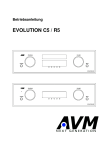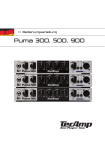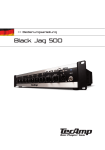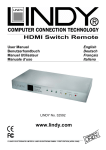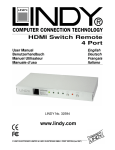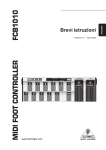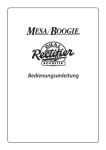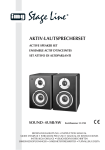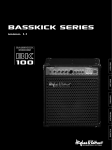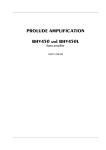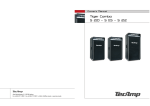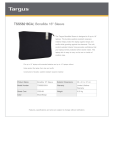Download BONAFIDE
Transcript
>> Bedienungsanleitung L05059 BONAFIDE WICHTIGE SICHERHEITSANWEISUNGEN! Alle Tecamp Geräte sind für einen dauerhaften, sicheren Betrieb ausgelegt. Wenn Sie sich an die folgenden Anweisungen halten, können Sie Schaden von sich, anderen und dem Gerät fernhalten. 1. Lesen Sie diese Sicherheitsanweisungen, bevor Sie das Gerät benutzen. 2. Verwahren Sie diese Anweisungen an einem sicheren Ort, um später immer wieder darauf zurückgreifen zu können. 3. Folgen Sie allen Warnhinweisen, um einen gesicherten Umgang mit dem Gerät zu gewährleisten. 4. Folgen Sie allen Anweisungen, die in dieser Bedienungsanleitung gemacht werden. 5. Betreiben Sie das Gerät nicht in der Nähe von Wasser oder in Umgebungen mit starker Kondenswasserbildung, z.B. im Badezimmer, in der Nähe von Waschbecken, Waschmaschinen, feuchten Kellern, Swimming Pools usw. 6. Verdecken Sie nicht die Lüftungsschlitze. Bauen Sie das Gerät so ein, wie der Hersteller es vorschreibt. Das Gerät sollte so aufgestellt werden, dass immer eine ausreichende Luftzufuhr gewährleistet ist. Zum Beispiel sollte das Gerät nicht im Bett, auf einem Kissen oder anderen Oberflächen betrieben werden, die die Lüftungsschlitze verdecken könnten, oder in einer festen Installation derart eingebaut werden, dass die warme Luft nicht mehr ungehindert abfließen kann. 7. Das Gerät sollte nicht in der Nähe von Wärmequellen betrieben werden (z.B. Heizkörper, Wärmespeicher, Öfen, starke Lichtquellen, Leistungsverstärker etc.). 8. Vermeiden Sie starke Temperaturschwankungen. 9. Achten Sie darauf, dass das Gerät immer geerdet und das Netzkabel nicht beschädigt ist. Entfernen Sie nicht mit Gewalt den Erdleiter des Netzsteckers. Bei einem Euro Stecker geschieht die Erdung über die beiden Metallzungen an beiden Seiten des Steckers. Die Erdung (der Schutzleiter) ist, wie der Name schon sagt, zu Ihrem Schutz da. Falls der mitgelieferte Stecker nicht in die örtliche Netzdose passt, lassen Sie den Stecker von einem Elektriker (und nur von einem Elektriker!) gegen einen passenden austauschen. 10.Schließen Sie den Verstärker nur an eine geerdete Steckdose mit der korrekten Netzspannung an. 11.Netzkabel sollten so verlegt werden, dass man nicht über sie stolpert, darauf herumtrampelt, oder dass sie womöglich von anderen spitzen oder schweren Gegenständen eingedrückt werden. Netzkabel dürfen nicht geknickt werden – achten Sie besonders auf einwandfreie Verlegung an der Stelle, wo das Kabel das Gerät verlässt sowie nahe am Stecker. 12.Verwenden Sie nur Originalzubehör und/oder solches, das vom Hersteller empfohlen wird. 13.Wird das verpackte Gerät mit einer Sackkarre transportiert, vermeiden Sie Verletzungen durch versehentliches Überkippen. 14.Ziehen Sie den Netzstecker bei Gewitter oder wenn es längere Zeit nicht gebraucht wird. 15.Das Gerät sollte unbedingt von nur geschultem Personal repariert werden, wenn: Das Netzkabel oder der Netzstecker beschädigt wurde, Gegenstände oder Flüssigkeiten in das Innere gelangt sind, das Gerät Regen ausgesetzt war, das Gerät offensichtlich nicht richtig funktioniert oder plötzlich anders als gewohnt reagiert, das Gerät hingefallen oder das Gehäuse beschädigt ist. Wartung: Der Anwender darf keine weiteren Wartungsarbeiten an dem Gerät vornehmen als in der Bedienungsanleitung angegeben. Sonstige Wartungsarbeiten dürfen nur von geschultem Personal durchgeführt werden. 16.Halten Sie das Gerät mit einem weichen, trockenen Lappen sauber. Wischen Sie es gelegentlich mit einem feuchten Tuch ab. Benutzen Sie keine anderen Reinigungs- oder Lösungsmittel, die die Lackierung oder die Plastikteile angreifen könnten. Regelmäßige Pflege und Überprüfung beschert Ihnen eine lange Lebensdauer und höchste Zuverlässigkeit. Entkabeln sie das Gerät vor der Reinigung. 17.Stellen Sie den Verstärker niemals auf eine Unterlage, die das Gewicht des Geräts nicht tragen kann. 18.Achten Sie immer darauf, dass die minimale Lastimpedanz der angeschlossenen Lautsprecher nicht unterschritten wird. 19.Vermeiden Sie hohe Lautstärken über einen längeren Zeitraum. Ihr Gehör kann massive Schäden davontragen – Hörverluste sind fortschreitend und irreversibel! VORSICHT: UM DIE GEFAHR VON STROMSCHLÄGEN ZU VERMEIDEN, ÖFFNEN SIE NICHT DAS GERÄT. ENTFERNEN SIE NIEMALS DIE ERDUNG AM NETZKABEL. SCHLIEßEN SIE DAS GERÄT NUR AN EINE ORDENTLICH GEERDETE STECKDOSE AN. WARNUNG: UM DIE GEFAHR VON STROMSCHLÄGEN ZU VERRINGERN, SETZEN SIE DAS GERÄT KEINER FEUCHTIGKEIT ODER SOGAR REGEN AUS. VORSICHT: IM INNEREN BEFINDEN SICH KEINE TEILE, ZU DENEN DER ANWENDER ZUGANG HABEN MUSS. REPARATUREN DÜRFEN NUR VON QUALIFIZIERTEM FACHPERSONAL DURCHGEFÜHRT WERDEN. VORSICHT: DIESES GERÄT IST IN DER LAGE, SEHR HOHE SCHALLDRÜCKE ZU ERZEUGEN. SETZEN SIE SICH NICHT LÄNGERE ZEIT HOHEN LAUTSTÄRKEN AUS, DIES KANN ZU BLEIBENDEN GEHÖRSCHÄDIGUNGEN FÜHREN. TRAGEN SIE UNBEDINGT GEHÖRSCHUTZ, WENN DAS GERÄT MIT HOHER LAUTSTÄRKE BETRIEBEN WIRD. ACHTUNG STROMSCHLAGGEFAHR, NICHT ÖFFNEN VORSICHT: UM DIE GEFAHR VON STROMSCHLÄGEN ZU VERMEIDEN, ENTFERNEN SIE KEINE ÄUSSEREN TEILE. DIESES GERÄT ENTHÄLT KEINE TEILE, ZU DENEN DER ANWENDER ZUGANG HABEN MÜSSTE. LASSEN SIE ALLE SERVICE LEISTUNGEN VON AUSGEBILDETEM FACHPERSONAL BEI EINER AUTORISIERTEN SERVICE WERKSTATT DURCHFÜHREN. BESCHREIBUNG DER SYMBOLE: GEFÄHRLICHE SPANNUNG: Dieses Dreieck mit dem Blitzsymbol auf Ihrem Gerät macht Sie auf nicht isolierte „gefährliche Spannungen“ im Inneren des Gerätes aufmerksam, stark genug um einen lebensbedrohlichen Stromschlag abzugeben. UNBEDINGT IN DER BEDIENUNGSANLEITUNG NACHSCHLAGEN: Dieses Dreieck mit dem Ausrufezeichen auf Ihrem Gerät weist Sie auf wichtige Bedienungs- und Pflegeanweisungen in den Begleitpapieren hin. WEEE: Entsorgung von gebrauchten elektrischen und elektronischen Geräten (anzuwenden in den Ländern der Europäischen Union und anderen europäischen Ländern mit einem separaten Sammelsystem für diese Geräte). Das Symbol auf dem Produkt oder seiner Verpackung weist darauf hin, dass dieses Produkt nicht als normaler Haushaltsabfall zu behandeln ist, sondern an einer Annahmestelle für das Recycling von elektrischen und elektronischen Geräten abgegeben werden muss. Durch Ihren Beitrag zum korrekten Entsorgen dieses Produkts schützen Sie die Umwelt und die Gesundheit Ihrer Mitmenschen. Umwelt und Gesundheit werden durch falsches Entsorgen gefährdet. Materialrecycling hilft den Verbrauch von Rohstoffen zu verringern. Weitere Informationen über das Recycling dieses Produkts erhalten Sie von Ihrer Gemeinde, den kommunalen Entsorgungsbetrieben oder dem Geschäft, in dem Sie das Produkt gekauft haben. >> Einleitung Durch die effektiven Klangregelmöglichkeiten werden alle Stilrichtungen hervorragend übertragen. Die zwei getrennten Kanäle mit Vierband-Klangregelung ermöglichen auf einfache Weise eine Vielzahl unterschiedlicher Sounds. Exklusive Features wie der »TASTE«-Regler erlauben es, das Timbre des Instruments zu charakterisieren. Effektweg, »LINE IN« und »LINE OUT« können wahlweise Stereo oder Mono betrieben werden. Die akribische Qualitätssicherung sorgt für absolute Betriebssicherheit. Der Einsatz ausschließlich hochwertigster Bauteile, die professionelle Verarbeitung und das einzigartige Konzept setzen den BONAFIDE an die Spitze der Premium-Bassverstärker unserer Zeit. Sie können sich freuen, denn Sie halten gerade die Bedienungsanleitung Ihres neuen TecAmp BONAFIDE in den Händen. In enger Zusammenarbeit mit dem Bass-Superstar Richard Bona hat TecAmp einen zweikanaligen Amp entwickelt für alle Bassisten, die mehrere Instrumente auf der Bühne spielen und unterschiedliche Sounds fahren möchten. So beherbergt der TecAmp BONAFIDE zwei vollkommen unabhängige Amps in einem ultrakompakten Gehäuse und bietet außerdem die Möglichkeit, gleichzeitig unterschiedliche Boxen anzuschließen. Mit zwei getrennten ultralinearen High-End Eingangsstufen und zwei ebenalls getrennten Endstufen kann der Bonafide wie zwei Verstärker eingesetzt werden, oder als Mono-Bassamp mit zwei Vorstufen oder aber als StereoVerstärker. Flexibler kann ein Bassverstärker nicht sein. ! EG-Konformitätserklärung für das Produkt/Type BONAFIDE Bassamp Wir erklären in alleiniger Verantwortung als Hersteller, dass dieses Produkt unter Beachtung der Betriebsbedingungen und Einsatzumgebung laut Bedienungsanleitung mit den folgenden Normen oder normativen Dokumenten übereinstimmt: EN 61000-3-2, EN 61000-3-3, EN 55013, EN 55020, EN 55022, EN 60065 gemäß den Bestimmungen der Richtlinien 89/336/EWG und 73/23/EWG. 3 >> Front Panel 1A 3A 4A 5A 6A 7A 8A Input Gain Taste Lo Lo Mid Hi Mid Hi 2A 9 A 10 A Master Mute 11 DI A+B Clip 10 0 Dry Rich 10 0 10 0 10 0 10 0 Input BONAFIDE 10 0 Clip 0 2B 1B 1 A/B 10 Gain 3B Dry Rich Taste 4B 0 10 Lo 5B 0 10 0 Lo Mid 6B A/B Hi Mid 7B INPUT 3 Stecken Sie den Klinkenstecker Ihres abgeschirmten Instrumentenkabels in die »INPUT«-Buchse. Wird der BONAFIDE ohne Fußschalter betrieben, können durch die Verwendung des Input A (oben) beide Kanäle zusammen und durch den Anschluss an Kanal B (unten) der einzelne Kanal betrieben werden. 2 10 A/B 0 10 Hi 8B 0 10 Master Mute 9 B 10 B Power 12 GAIN Der »GAIN«-Regler erlaubt eine optimale Anpassung des Instruments an den BONAFIDE. Leuchtet die »CLIP«-LED (#2) während des Spielens auf, kann durch Zurückdrehen des »GAIN«-Reglers (#3) das Instrument perfekt angepasst werden. Stellen Sie den »VOLUME«-Regler Ihres Instruments nicht zu gering ein, da sich sonst Störungen auf dem Signalweg des BONAFIDE stärker bemerkbar machen. CLIP Die »CLIP«-LED dient zur optischen Kontrolle, um das Instrument korrekt an die Vorstufe des BONAFIDE anzupassen. Drehen sie den «GAIN«-Regler (#3) so weit auf, bis es während des Spielens auf dem Instrument bei großen Impulsen zum Aufleuchten der Clip LED kommt. Drehen Sie dann den »GAIN«-Regler (#3) soweit zurück, bis die Clip LED nicht mehr aufleuchtet. Das Ansprechen der »CLIP«-LED signalisiert, dass der Eingang der Vorstufe übersteuert und der »GAIN«-Regler (#3) zurückgedreht werden sollte. 4 A/B TASTE Der »TASTE«-Regler stellt eine Besonderheit des BONAFIDE dar. Dreht man den Regler in Richtung »RICH« nach rechts (im Uhrzeigersinn), wird der Ton zunehmend molliger und stärkt die Punch-Bässe bis hin zum warmen Vintage-Ton. Dreht man ihn nach links in Richtung »DRY«, bietet der »TASTE«-Regler die Möglichkeit, den knackigen Attack und knurrige Mitten stärker herauszustellen. 4 oberen Frequenzbereichs. Durch Drehen des Reglers kann man zwischen einem glasklaren, knalligen Rockbass-Sound oder einem abgedämpften Mute-Sound mit Reggae-Charakter wählen. Die Einsatzfrequenz des »HI«-Reglers liegt bei 8 KHz. mit einer Flankensteilheit von 15 dB. Mit dem »TASTE«-Regler kann man schnell und effektiv Instrumente, die ein wenig scharf und bissig klingen, etwas abmildern. Genauso ist es möglich, Bässen mit einem wummernden, undefinierten Halstonabnehmer durch Drehen in die »DRY«-Position mehr Definition zu geben. 9 5 A/B LO Der »LO«-Regler regelt die Anhebung bzw. Absenkung um plus/minus 15 dB bei einer Frequenz von 30 Hz. Hierdurch wird ein mächtiger, klarer Bassdruck erzeugt. 10 6 A/B LO MID A/B HI MID Der »HI MID«-Regler regelt – wie auch der »LO MID«Regler (#6) – breitbandiger als der »LO«-Regler (#5). Er bestimmt die Anhebung bzw. Absenkung des oberen mittleren Frequenzbandes der Bassgitarre. Dieses Band arbeitet bei 800 Hz. mit plus minus 12 dB Flankensteilheit. Beide Mittenbänder wurden bewusst nicht so steilflankig gestaltet, um bei aufgedrehtem Regler einem dröhnendem Basssound entgegenzuwirken. Dreht man den »HI MID«-Regler zurück, erzielt man den beliebten mittenarmen Funksound von allererster Qualität. 8 A/B MASTER A/B MUTE Die »MUTE«-Schalter sollte beim Einschalten des BONAFIDE gedrückt sein (LED leuchtet rot). In dieser Stellung wird das Instrumentensignal nicht an die Ausgänge weiter geleitet. Allerdings gelangt das Instrumentensignal weiterhin an die »TUNER«-Buchse (#14), so dass geräuschlos gestimmt werden kann. Sie müssen dafür nicht extra den Lautstärkeregler herunter drehen. Auch bei einem Instrumentenwechsel bietet sich dieser Schalter an, weil dann lästige Kontaktgeräusche vom Klinkenstecker unterbunden werden. Der »MUTE«-Schalter unterbricht auch den symmetrischen XLR DI Ausgang (#11). In Spielpausen sollte der Verstärker nicht ausgeschaltet, sondern der »MUTE«-Betrieb eingestellt werden. Die lüftergekühlte Endstufe wird dann im »MUTE«-Betrieb, falls notwendig, heruntergekühlt. Wird der »MUTE«-Schalter nicht gedrückt (LED leuchtet blau), nimmt der Bonafide seinen Betrieb auf und lässt an alle zugewiesenen Ausgänge Signal fließen. Eine wichtige Funktion übernimmt der mitgelieferte Fußschalter, der es erlaubt die Kanäle zu steuern. Lesen Sie bitte hierzu den Punkt 23 FOOTSWITCH dieser Anleitung. Der Arbeitspunkt des »LO MID«-Reglers liegt bei 250 Hz. Bei dieser Frequenz können die tiefen Mitten um jeweils 12 dB angehoben beziehungsweise abgesenkt werden. Dieser Regler erzeugt beim Aufdrehen den richtigen Kick, um den Bass-Sound im Bandgefüge weiter nach vorne treten zu lassen. 7 A/B Mit diesem Regler wird die Ausgangslautstärke des Verstärkers eingestellt. Er hat gleichzeitig Einfluss auf den Pegel des »LINE OUT« (#17) auf der Geräterückseite. HI Der »HI«-Regler regelt die Anhebung bzw. Absenkung des 5 >> Front Panel >> Rear Panel 1A 3A 4A 5A 6A 7A 8A Input Gain Taste Lo Lo Mid Hi Mid Hi 2A 9 A 10 A Master Mute 11 14 21a 22 19a 20 18a 24 25 17a 17b 16A 23 17c 17d 16B 15 DI A+B Clip 0 10 Dry Rich 0 10 Dry Rich 0 10 0 10 0 10 0 10 0 10 0 10 0 10 Input BONAFIDE 10 0 Clip 0 2B 1B Gain 3B Taste 4B Lo 5B Lo Mid 6B Hi Mid 7B 11 DI 10 Hi 8B 0 10 Master Mute 9 B 10 B Power 12 auf der Vorderseite befindliche »POWER«-Schalter (#12) eingeschaltet ist, leuchtet die LED des »POWER«-Schalters – unabhängig von weiteren Schalterstellungen. Diese männliche XLR Buchse liefert ein symmetrisches Vorstufen-Signal zum Anschluss an die PA, für Aufnahmezwecke oder zum Ansteuern eines weiteren Verstärkers mit symmetrischen Eingängen. Durch die Verwendung hochwertiger Bauteile ist die Qualität des »DI«-Ausgangs auch besonders für Aufnahmen im Tonstudio geeignet. Das Signal stellt die Summe beider Kanäle hinter der jeweiligen Klangreglung (Post-Modus) bereit, wird aber nicht von der jeweiligen Master-Volumen-Stellung (9 A/B) beeinflusst. 12 POWER Mit dem »POWER«-Schalter wird der BONAFIDE eingeschaltet. Wenn das Gerät eingeschaltet ist (am Schalter muss die Oberseite herunter gedrückt sein), leuchtet zur Kontrolle die auf dem Schalter befindliche blaue LED auf. Wenn das mitgelieferte Netzkabel an der auf der Rückseite befindlichen Netzbuchse (#13) eingesteckt und der 6 13 13 a 21 19 18 13 Netzkabel/Netzanschluss Service-Techniker behoben werden sollte. Bei den Sicherungen handelt es sich um Schmelzsicherungen mit 6,3 A/Träge und den Abmaßen 5 x 20 mm. Im Sicherungsfach (#13a) befindet sich eine Ersatzsicherung. Ihr BONAFIDE besitzt einen Anschluss für ein Kaltgerätekabel (#13), an das Sie das mitgelieferte Netzkabel anschließen. Stecken Sie den weiblichen Kaltgerätestecker fest in die Netzbuchse. Bei dem Netzkabel muss es sich auf jeden Fall um ein dreipoliges, geerdetes Kabel mit Schukostecker handeln. Versuchen Sie bitte niemals, die Masseverbindung (Erdung) am Schukostecker durch Abkleben oder ähnliches zu unterbrechen, wenn Sie eine Brummschleife haben. Die im Sicherungsfach (#13a) untergebrachte Sicherung schützt das Gerät vor Schäden, die durch Überlastung oder Beeinträchtigungen bzw. Fehler in der Netzversorgung entstehen. Wenn die Sicherung anspricht und durchbrennt, darf sie nur durch eine gleichen Typs und Werts ersetzt werden. Sollte die Netzsicherung nach Austausch sofort wieder durchbrennen, liegt ein ernsthafter Schaden vor, der nur durch einen autorisierten 14 Voltage Der BONAFIDE besitzt einen »VOLTAGE«-Selektor, mit dem die Betriebsspannung des Gerätes auf die der Netzspannung angepasst werden kann. Werksseitig ist der »VOLTAGE«-Selektor auf 230 Volt eingestellt. Sollten Sie zum Beispiel den BONAFIDE in den USA betreiben, muss der »VOLTAGE«-Selektor auf 115 Volt eingestellt werden ACHTUNG: Prüfen Sie bei jeder Inbetriebnahme, ob der »VOLTAGE«-Selektor auf die richtige Betriebsspannung eingestellt ist. Falsche Einstellung kann hier zu großen Schäden am Gerät führen. 7 >> Rear Panel 14 21a 13 13 a 22 19a 21 20 19 18 Diese Buchse dient zum Anschluss eines Stimmgerätes. Hier liegt das Signal von beiden Vorstufen des BONAFIDE an. Um ein lautloses Stimmen zu ermöglichen, ist sie immer aktiv, auch wenn sich der BONAFIDE in der «MUTE»-Stellung befindet, A/B LINE OUT An dieser Buchse kann eine zusätzliche Endstufe angeschlossen werden. Außerdem besteht die Möglichkeit, das Bass-Signal des jeweiligen Kanals getrennt auf die P.A. zu geben oder zum Recording zu benutzen. Der »MASTER«-Regler (#9 A / B ) legt die Lautstärke fest. 17 A/B 18 SPEAKER BRIDGED MODE 19 CHANNEL B Beim BONAFIDE stehen drei Speakon® Combo-Anschlüsse vom Typ NLJ2MD-V zur Verfügung. An diesen Buchsen kann wahlweise ein 2- bzw. 4-poliger Speakon®-Stecker oder ein 6,3 mm Klinkenstecker angeschlossen werden. Wegen der hohen Ausgangsleistung des BONAFIDE empfehlen wir die Verwendung von Speakon®-Steckern. Die Anschlüsse sind mit 1- = minus und 1+ = plus belegt. Beim Betrieb im «BRIDGED MODE» (#18a) ist darauf zu achten, dass die Gesamtimpedanz von 4 Ohm nicht un- Die Buchse des »CHANNEL B« (#19) kann mit 2 Ohm belastet werden. Die Ausgangsleistung am »CHANNEL B« beträgt 350 Watt an 4 Ohm bzw. 450 Watt an 2 Ohm. »CHANNEL A« (#21) kann gleichzeitig mit »CHANNEL B« (#19) betrieben werden. Es können also insgesamt 2 Boxen mit je 2 Ohm oder 4 Boxen mit 4 Ohm gleichzeitig am BONAFIDE angeschlossen werden. Beide Kanäle besitzen separate Lautstärkenregler (#19a und #21a), die es erlauben, je Kanal unterschiedliche Pe- 25 17a 17c 15 TUNER A/B 16 schiedliche Effektgeräte den einzelnen Kanälen zuzuweisen. Verbinden Sie die Buchse »SEND« (#17a/#17c) mit dem Eingang und die Buchse »RETURN« (#17b/#17d) mit dem Ausgang Ihres Effektgerätes. Die »RETURN«-Buchse (#17b/#17d) kann außerdem genutzt werden, um externe Audioquellen (z.B. MP3-Player) bzw. die Endstufe des BONAFIDE separat zu betreiben. Die Endlautstärke wird mit dem »MASTER«-Regler (#9A/B) festgelegt. terschritten wird! Drücken Sie unbedingt den »BRIDGED MODE«-Schalter (#18a) in die »ON«-Position, bis er einrastet. Der »BRIDGED«-Kanal ist nun betriebsbereit und die »VOLUME«-Potis (#19a und #21a) von »CHANNEL A« (#21) und »CHANNEL B« (#19) sowie der »SUB«-Filter (#20) sind außer Betrieb gesetzt. Dieser Ausgang ist perfekt geeignet, um hochbelastbare Boxen wie zum Beispiel die L 610 oder die Bad Cab zu betreiben. An dieser »BRIDGED MODE«-Buchse (#18) steht die volle Ausgangsleistung von 700 Watt an 8 bzw. 900 Watt an 4 Ohm zur Verfügung. In diesem Fall dürfen die Buchsen von Channel A (#21) und Channel B (#19) nicht benutzt werden. TIPP: Achten Sie beim Anschluss von Lautsprecherboxen auf ausreichenden Querschnitt des Kabels (wir empfehlen min. 2 x 2,5 mm2). Um den BONAFIDE an die jeweilige Box anzuschließen sollten Kabel mit Speakon®-Steckern vom Typ NL2FC (2-polige Ausführung) oder NL4FC (4-polige Ausführung) benutzt werden. Bei beiden SteckerAusführungen muss der Pluspol des Lautsprecherkabels an die mit 1+ gekennzeichnete Klemme des Steckers und der Minuspol des Kabels an die mit 1- gekennzeichnete Klemme angeschlossen werden. 18a 24 EFFECTS LOOP RETURN/SEND Dieser serielle Effekteinschleifweg dient zum Anschluss eines oder mehrerer Effektgeräte. Der BONAFIDE besitzt zwei völlig getrennte Effektwege. Diese erlauben unter- 8 17b 17d 16A 16B 23 15 gel der angeschlossenen Boxen einzustellen. Stellen Sie sicher, dass der «BRIDGED»-Schalter (#18a) sich in der »OFF«-Position befindet, um die Kanäle A und B in der Lautstärke zu regeln. 20 SUB Als weitere Besonderheit besitzt der »CHANNEL B« (#19) einen »SUB«-Schalter (#20) mit dem gleichzeitig zwei Funktionen geschaltet werden. Wird der Schalter gedrückt, schneidet ein Filter alle Frequenzen oberhalb 200 Hz. ab. Gleichzeitig wird der Pegel des verbleibenden Signals um 12 dB angehoben. Dieser Schalter ist perfekt geeignet, um das TecAmp Pleasure Board gleichzeitig mit einer Box, die am »CHANNEL A« (#21) betrieben wird zu kombinieren, oder eine weitere Bassbox als reinen Subwoofer zu betreiben. 21 CHANNEL A Die Buchse des »CHANNEL A« (#21) kann ebenfalls mit 2 Ohm belastet werden. Die Ausgangsleistung am »CHANNEL A« beträgt 350 Watt an 4 Ohm bzw. 450 Watt an 2 Ohm. »CHANNEL A« (#21) kann gleichzeitig mit »CHANNEL B« (#19) betrieben werden. Auch »CHANNEL A« (#21) besitzt einen separaten Lautstärkenregler, der es erlaubt, je Kanal unterschiedliche Pegel der angeschlossenen Boxen einzustellen. Stellen Sie sicher, dass der »BRIDGED«-Schalter (#18a) sich in der »OFF«-Position befindet, um die Kanäle A und B in der Lautstärke zu regeln. 22 MONO Dieser Schalter ermöglicht, die beiden Vorstufenkanäle separat oder gemeinsam an die beiden Endstufen zu routen. Ist der »Mono« Schalter (#22) nicht gedrückt, 9 >> Rear Panel & Footswitch 23b arbeitet die Endstufe im Stereobetrieb. Ist am Vorstufenkanal A ein Instrument angeschlossen, wird das Signal ausschließlich an den Endstufenkanal A weitergeleitet. Vorstufen und Endstufenkanal B arbeitet identisch. Somit besteht die Möglichkeit, den BONAFIDE als zwei komplett getrennte Bassamps zu betreiben. Man erhält die Möglichkeit, zwei unterschiedliche Instrumente über getrennte Kanäle an unterschiedliche Boxen anzuschließen. Diese Variante nutzt man, um sein Basssignal, das mittels Effektgeräten in ein Stereo Signal gewandelt wird, auch auf der Bühne in Stereo zu genießen. Stellen Sie sicher, dass der »BRIDGED«-Schalter (#18a) sich in der »OFF«-Position befindet. Ist der »MONO«-Schalter (#22) gedrückt, arbeitet der Verstärker im Mono-Betrieb. Ist am Vorstufenkanal A ein Instrument angeschlossen, wird das Signal nun an beide Endstufenkanäle A und B weitergeleitet. Ist am Vorstufenkanal B ein Instrument angeschlossen, wird das Signal hier ebenfalls an beide Endstufenkanäle A und B weitergeleitet. Mit dieser Schaltungsvariante besteht die Möglichkeit, jedes Instrument, egal an welchem Vorstufenkanal es angeschlossen ist, an beide Endstufenblöcke zu routen. Der BONAFIDE bietet die Möglichkeit, gleichzeitig zwei unterschiedliche Instrumente über getrennte Vorstufenkanäle an allen angeschlossenen Boxen zu betreiben. 23d 23a 23c 23a CHANNEL A / B Sollen die Kanäle des BONAFIDE getrennt betrieben werden, bietet der Fußschalter (#23a) die Möglichkeit, zwischen den Kanälen hin und her zu schalten. Leuchtet die blaue LED am Fußschalter (#23b) auf, ist der Kanal A (oberer Kanal) in Betrieb. Gleichzeitig ist der Kanal B (unterer Kanal) im »MUTE«-Betrieb. So kann ein Aufschwingen der Seiten eines nicht benutzten Instrumentes verhindert werden. 23c COMBINE Wird die »COMBINE«-Funktion am Fußschalter aktiviert, leuchtet zur Kontrolle die LED am Fußschalter (#23d) rot. Beide »MUTE«-LEDs am BONAFIDE leuchten in diesem Fall nicht. Ist die »COMBINE«-Funktion ausgeschaltet, schaltet nur der über den Channel Switch angewählte Kanal auf Betriebsbereitschaft. Seine »MUTE«-LED leuchtet zur Kontrolle blau. Die »MUTE«-Funktion an den beiden »MUTE«-Schaltern (#10) des BONAFIDE bleibt auch bei angeschlossenem Fußschalter erhalten. Wird einer der beiden »MUTE«- 23 FS An diese 6,3 mm Stereo-Klinkenbuchse wird der mitgelieferte Fußschalter FS BONAFIDE angeschlossen. Stecken Sie das mitgelieferte Stereo-Klinkenkabel in die »FS« Buchse des BONAFIDE und verbinden Sie das andere Ende des Kabels mit dem Fußschalter. Der Fußschalter verfügt über einen Kanalumschalter und eine »COMBINE«-Funktion. 10 Schalter am BONAFIDE gedrückt, wird dies durch eine rote LED des jeweiligen Kanals angezeigt. Leuchtet also am BONAFIDE eine »MUTE«-LED rot, ist dieser Kanal durch den am BONAFIDE befindlichen »MUTE«-Schalter außer Betrieb. in ein 19“ 2HE-Rack eingeschraubt werden. Verwenden Sie zur Montage der Rackwinkel den im Lieferumfang enthaltenen 2,5 mm Innensechskantschlüssel. 25 PHONE OUT Technische Daten: Dieser 3,5mm Stereo Klinkenausgang dient zum Anschluss eines Kopfhörers. Mit dem «MASTER»-Regler (#9) wird sowohl die Lautstärke des Instrumentes als auch der Pegel des am AUX-IN angeschlossen Gerätes festgelegt. Der Betrieb des BONAFIDEist ohne eine angeschlossene Box möglich. Somit kann das Gerät in jeder Situation betrieben werden. Beide Kanäle Eingangsimpedanz: 1 mOhm Empfindlichkeit: max -26 dBu Impedanz EFFFECTS LOOP EFFECT SEND: 600 Ohm EFFECT RETURN/LINE IN: 10 kOhm Nennpegel: 0 dBu Impedanz LINE OUT: 600 Ohm Nennpegel LINE OUT: +6 db DI-Impedanz: 600 Ohm DI-Nennpegel: +6 dBu Tone Control LO: 30Hz/+-15dB LO MID: 250Hz/+-12dB HI MID: 800Hz/+-12dB HI: 8k/+-15dB output power rating 2 x 350 watts @ 4 ohms 2 x 450 watts @ 2 ohms 1 x 700 watts @ 8 ohms mono bridged 1 x 900 watts @ 4 ohms mono bridged Fuse: 115/230 V/AC 6,3 A/T (Slow Blow) 5 x 20 mm Dimensions W x H x D: 27 x 8 x 25 cm; 10,6” x 3,1” x 10” Weight: 2,2 kg; 4,85 lbs 24 AUX IN Dieser 3,5 mm Stereo Klinkeneingang ist zum Anschluss eines MP3-Players, iPhone oder anderer externer Musikquellen vorgesehen. Das eingespeiste Signal kann mit dem «MASTER»-Regler (#9a/9b) dem Signal des Instrumentes beigemischt werden. Verwenden Sie zum Anschluss Ihrer Audioquelle das mitgelieferte 3,5mm Stereo-Klinkenkabel. Rackmontage Die beiden zum Lieferumfang gehörenden Rackmontagewinkel dienen zur Befestigung des BONAFIDE in einem 19“ Rack. Zwei Höheneinheiten nimmt der BONAFIDE im Rack ein. Für die Montage der Winkel sind an den Seiten des BONAFIDE jeweils drei Gewindebuchsen vorhanden, die im Auslieferungszustand bereits mit den Befestigungsschrauben versehen sind. Es ist jeweils ein rechter und ein linker Rackbefestigungswinkel im Lieferumfang enthalten. Bei Bedarf kann der BONAFIDE somit problemlos 3 Alter Bahnhofsweg 5 · D-35745 Herborn Fon +49 (0) 2777-6391 · e-Mail: [email protected] · www.tecamp.de >> Manual L05059 BONAFIDE >> Introduction Important Safety Instructions The apparatus shall not be exposed to dripping or splashing and that no objects with liquids, such as vases, shall be placed on the apparatus. The MAINS plug is used as the disconnect device, the disconnect device shall remain readily operable. Warning: the user shall not place this apparatus in the area during the operation so that the mains switch can be easily accessible. 1. Read these instructions before operating this apparatus. 2. Keep these instructions for future reference. 3. Heed all warnings to ensure safe operation. 4. Follow all instructions provided in this document. 5. Do not use this apparatus near water or in locations where condensation may occur. 6. Clean only with dry cloth. Do not use aerosol or liquid cleaners. Unplug this apparatus before cleaning. 7. Do not block any of the ventilation openings. Install in accordance with the manufacturer’s instructions. 8. Do not install near any heat sources such as radiators, heat registers, stoves, or other apparatus (including amplifiers) that produce heat. 9. Do not defeat the safety purpose of the polarized or groundingtype plug. A polarized plug has two blades with one wider than the other. A grounding type plug has two blades and a third grounding prong. The wide blade or the third prong is provided for your safety. If the provided plug does not into your outlet, consult an electrician for replacement of the obsolete outlet. 10.Protect the power cord from being walked on or pinched particularly at plug, convenience receptacles, and the point where they exit from the apparatus. 11.Only use attachments/accessories specified by the manufacturer. 12.Use only with a cart, stand, tripod, bracket, or table specified by the manufacturer, or sold with the apparatus. When a cart is used, use caution when moving the cart/apparatus combination to avoid injury from tipover. 13.When a cart is used, use caution when moving the cart/apparatus combination to avoid injury from tipover. 14.Unplug this apparatus during lighting storms or when unused for long periods of time. 15.Refer all servicing to qualified service personnel. Servicing is required when the apparatus has been damaged in any way, such as power-supply cord or plug is damaged, liquid has been spilled or objects have fallen into the apparatus, the apparatus has been exposed to rain or moisture, does not operate normally, or has been dropped. CAUTION: Use of controls or adjustments or performance of procedures other than those may result in hazardous radiation exposure. WARNING: To reduce the risk of FIRE or electric shock, do not expose this apparatus to rain or moisture. CAUTION: RISK OF ELECTRIC SHOCK DO NOT OPEN CAUTION: TO REDUCE THE RISK OF ELECTRIC SHOCK, DO NOT REMOVE COVER (OR BACK) NO USER SERVICEABLE PARTS INSIDE REFER SERVICING TO QUALIFIED PERSONNEL The lightning flash with arrowhead symbol, within an equilateral triangle, is intended to alert the user to the presence of uninsulated “dangerous voltage” within the product’ s enclosure that may be of suficient magnitude to constitute a risk of electric shock to persons. The exclamation point within an equilateral triangle is intended to alert the user to the presence of important operating and maintenance (servicing) instructions in the literature accompanying the appliance. ! You wouldn’t find a bass amp which is more flexible. The very effective tone controls suit all musical styles. The two separate preamps boast a four-band tone control section which lets you easily dial any sound you want. Exclusive features like the TASTE control allow you to emphasize the tonal characteristics of the individual instrument. Effects loops, LINE IN and LINE OUT can be chosen to be operated mono or stereo. The meticulous quality control during all stages of production guarantees failsafe performance. Using only the best components available the unique circuit design and the professional workmanship make the BONAFIDE today’s state-of-the-art in top-of-the-line bass amp manufacturing. Congratulations! You are now the proud owner of a TecAmp BONAFIDE bass amplifier. This manual will help you get to learn all the useful and exciting features of one of the best amplifiers in the world. In close cooperation with Bass-hero Richard Bona TecAmp have been able to develop a two-channel amp for all those of you who want to play several instruments on stage or are looking for different sounds at the flick of a switch. This is because the TecAmp BONAFIDE sports two completely independent amps in an ultra-compact housing, while at the same time offering the possibility to run different cabinets simultaneously. The BONAFIDE, featuring two independent ultra-flat premium preamps and two independent power amp sections, can be used as two separate amplifiers, as a mono amp with two different preamps, or a full stereo amp. CE Declaration of Conformity BONAFIDE Bassamp We declare under our sole responsibility that this product is in conformity with the following standards or standardization documents in attention of operation conditions and installation arrangements according to operating manual: EN 61000-3-2, EN 61000-3-3, EN 55013, EN 55020, EN 55022, EN 60065 according to the provisions of the regulations 89/336/EWG and 73/23/EWG. 3 >> Front Panel 1A 3A 4A 5A 6A 7A 8A Input Gain Taste Lo Lo Mid Hi Mid Hi 2A 9 A 10 A Master Mute 11 DI A+B Clip 0 10 Dry Rich 0 10 Dry Rich 0 10 0 10 0 10 0 10 0 10 0 10 0 10 Input BONAFIDE 10 0 Clip 0 2B 1B 1 A/B Gain 3B Taste 4B Lo 5B Lo Mid 6B 7B INPUT A/B 10 Hi 8B 0 10 Master Mute 9 B 10 B Power 12 the “GAIN” control (#3). Keep in mind that excessive use of the “LO” (#5) and “LO MID” (#6) controls will raise the internal level and thus make the “CLIP” LED come on much earlier. Plug in your shielded instrument cable into this jack. We advise you to always turn down the volume control on your instrument before plugging it into this jack. If you operate the BONAFIDE without the footswitch, using “INPUT A” will allow you to use both preamps at the same time, while plugging into “INPUT B” will route the signal through preamp B only. 2 Hi Mid 3 A/B GAIN This control adjusts the basic signal level in the preamp and thus determines it’s sensitivity and overall dynamic characteristics. In order to best adjust your instrument’s signal level to the internal operating level of the BONAFIDE watch the “CLIP” LED (#2). Set the “GAIN” such that the “CLIP” LED just doesn’t light up. Do not leave the volume control on your instrument set too low, otherwise noise picked up along the cable will become more prominent and thus lower the signal-to noise ratio of the amp. CLIP The red “CLI”P LED gives you a visual control while adjusting the input sensitivity of the BONAFIDE preamp so that the signal from your instrument best matches the preamp’s internal operating level. Turn up the “GAIN” control (#3) while you hit the strings of your bass heavily until the “CLIP” LED starts flashing. Now back up the “GAIN” control a bit until the LED lights up no longer. The flashing “CLIP” LED tells you that the input stage of the preamp is clipping and that you should turn down 4 A/B TASTE The “TASTE” control is a unique feature of the BONAFIDE. 4 Leave the control in the centre position if you seek a more “natural” sound. Turn it clockwise to the right towards “RICH” in order to increasingly fatten up the sound with lots of low-end punch, ending in a warm, vintage tone. Turning this control counter-clockwise to the left towards “DRY” it will add urgent attack and midrange growl. The “TASTE” control allows you to quickly and effectively soften those instruments which sound a little harsh and scathing. At the same time bass guitars with a muddy, booming neck pickup gain definition by turning the “TASTE” control towards the “DRY” position. 5 A/B Turning up the “HI MID” control gives you a great fretless sound. When you cut the “HI MID” range you end up with a funky slap sound of extremely high quality. 8 9 A/B LO 10 A/B A/B MASTER A/B MUTE The “MUTE” switch should be depressed when you power up or down your BONAFIDE – the LED above the switch illuminates red when the channel is muted. In this mode no audio signal will be processed and heard at any output except the “TUNER” jack (#15). That way you don’t have to turn down the volume for silent tuning or when changing instruments, doing without those nasty noises you usually hear when you unplug the jack. The “MUTE” switch also interrupts the signal path at the balanced “DI OUT” (#11) - that way your silent tuning or changing instruments won’t be heard in the PA, either. During breaks the amp should be set to “MUTE” rather than switched off completely. That way the internal fan stays on and cools down the power amp circuitry if necessary. Disengage the “MUTE” function (the LED illumi- LO MID The “LO MID” control, centred at 250 Hz, allows you to cut or boost the low mid frequencies up to 12 dB. The slope of this control is not as steep as the one of the “LO” control (#5). This control, when turned up, emphasizes the body of the bass guitar and lets it kick out in a mix. Turn it counter-clockwise to reduce unwanted room resonances. 7 HI This is the overall volume control of the respective channel in the BONAFIDE and works on the internal power amp. It determines the level at the “SPEAKER OUTPUTS” (#17 - #20) as well as the “LINE OUT” jack on the back panel (#15). Note that it does not determine the level at the balanced “DI OUT” (#11). This control affects the low frequencies. It allows for cutting or boosting the frequency range around 30 Hz by 15 dB each. This frequency range represents the bottom end and massive yet distinguished punch in a bass guitar. Start from the 12 o’clock position and dial in the sound you like. 6 A/B The “HI” control is centred at 8 kHz and offers a cut or boost of 15 dB. Turn it up for a biting, crystal clear rock or funk bass. Turn it counter clockwise to reduce hiss or generally dampen the sound for a muted reggae feel. HI MID The “HI MID” control is centred at 800 Hz and offers a cut or boost of 12 dB, again with a more gentle slope just like the “LO MID” control (#6). These controls intentionally have a broader range – that way the sound never gets booming or honky when you turn them all the way up. 5 >> Front Panel >> Rear Panel 1A 3A 4A 5A 6A 7A 8A Input Gain Taste Lo Lo Mid Hi Mid Hi 2A 9 A 10 A Master Mute 11 14 21a 22 19a 20 18a 24 25 17a 17b 16A 23 17c 17d 16B 15 DI A+B Clip 0 10 Dry Rich 0 10 Dry Rich 0 10 0 10 0 10 0 10 0 10 0 10 0 10 Input BONAFIDE 10 0 Clip 0 2B 1B Gain 3B Taste 4B Lo 5B Lo Mid 6B Hi Mid 7B 10 Hi 8B 0 10 Master Mute 9 B 10 B Power 12 nates blue) and start to rumble – now there is signal at all outputs again. The footswitch, which comes with the amp, has an important function in switching the channels. Please refer to point (#23) “FOOTSWITCH” in this manual for further information. The “DI OUT” signal is a mono mix of both preamps. It is tapped after the bass signal has passed both preamps (POST MODE) including the “GAIN” controls (#3 A/B), the tone control section (#5 through #8), and the “EFFECTS LOOP” (#16). It is not affected by the “MASTER” controls (#9 A/B), though. 11 DI 12 POWER This male XLR output supplies a balanced line signal for connecting to a house mixing board, recording console or external amplifier(s) with balanced inputs. The need for an additional active DI box, which can be pretty expensive, is obsolete. Due to the advanced circuit design, using only the best components available, the high sound quality of the “DI OUT” makes the BONAFIDE the amp of choice in any recording studio (you can use the BONAFIDE pre amps on their own without driving any speakers). There is no need to be afraid of nasty ground loops as the DI output is soft-grounded. At the risk of stating the obvious, this stylish yet heavy-duty rocker switch is used to switch the BONAFIDE on and off. Before you turn on the amp do make sure that the “MUTE” switches (#10 A/B) are depressed. Activating the “POWER SWITCH” (the top of the switch must be depressed towards the amp chassis) will make the small blue LED in the switch illuminate (provided the power cord supplied with the amp is plugged into the “POWER RECEPTACLE” (#13) and the other end to an appropriate power outlet). The amp is OFF when the bottom of the “POWER SWITCH” is depressed – the LED will no longer illuminate. 6 13 13 a 21 19 18 13 POWER RECEPTACLE If you suspect a blown fuse, disconnect the cord, pull out the FUSE DRAWER which is located just below the cord receptacle, and replace the fuse with another suitable fuse (4 A SLO BLO 5 x 20 mm). There should be a spare fuse in the fuse drawer. If two fuses blow in a row, something is very wrong. Do not open the unit. Refer service to qualified service personnel. Connect the supplied AC power cord to the power receptacle. Make sure the Euro plug is firmly inserted in the socket. The other end of the cable should be connected to any standard grounded AC outlet. Don’t worry about the voltage – our “smart voltage circuitry” operates at voltages between 90 and 260 volts. You can plug the BONAFIDE into any outlet providing a voltage within this range. Just in case you lose the cord provided, the jack accepts a standard 3-prong IEC cord like those found on most professional gear and computers – you can get one at any electronics, music or computer store. Never (!) remove or otherwise attempt to defeat the ground pin of the power cord in order to get rid of a hum induced by a ground loop! 14 VOLTAGE The BONAFIDE features a “VOLTAGE SELECTOR” allowing you to use your amplifier anywhere in the world just by the flick of a switch. The unit is set to 230 V when we ship to a country in Europe. Should you wish to use your BONAFIDE in the USA set the “VOLTAGE SELECTOR” to “115 V”. ATTENTION: Don’t forget to set it back to “230 V” when you return home! TecAmp cannot be made responsible for damages to the unit caused by improper voltage selection. Therefore it is a good 13a Power Fuse The BONAFIDE is fused for your and its own protection. 7 >> Rear Panel idea to always check the “VOLTAGE SELECTOR” before powering up the unit. Always use high quality shielded instrument cables for connecting to and from external devices. Keep the cables as short as possible. If you notice crackling distortion when using external effects, either the batteries of the stomp box have run out, or the send level of the amplifier is too high for the processor’s input stage. In this case you better connect the device between bass guitar and amplifier. The “RETURN” jack (#16b) can also be used to connect various external audio sources to the BONAFIDE, such as an MP3 player, or in order to just use the power amp of the BONAFIDE. The “MASTER” control (#9 A/B) determines the final output level. 15 TUNER A/B This jack is provided for connection to an electronic tuner and is always “live” even when the BONAFIDE is in “MUTE” mode (#10). This allows for silent tuning as well as providing a monitor feed which stays hot even when the house mix is muted. The jack provides a mono mix of both channel inputs after their respective “GAIN” controls (#3 A/B). 16 A/B LINE OUT These jacks provide line level signals for connection to separate power amps, PA mixing console or recording equipment. The volume of the signals is controlled by the respective “MASTER” control (#9 A/B). Note that the outputs are muted when the respective “MUTE” function (#10 A/B) is engaged. 17 A/B 18 SPEAKER – BRIDGED MODE BONAFIDE sports three Neutrik Speakon® NL4 MP speaker outputs. The wiring of the pins is as follows: 1+ = hot, 1- = ground. The one on the right (looked from behind) is reserved for mono bridged operation. When operating the amp in MONO BRIDGE MODE care should be taken that the minimum load is no less than 4 ohms. EFFECTS LOOP cabinets with an impedance of 2 ohms each or four cabinets with an impedance of 4 ohms each to the BONAFIDE simultaneously. put power at a minimum load of 4 ohms (700 watts at 8 ohms). Be absolutely certain that the speaker cabinet(s) connected is (are) able to handle the extremely high output power of the amp. All TecAmp cabinets featuring at least 4 speakers will do the job easily (e.g. L410, XL612, L610, etc.). When you use a speaker cabinet with a lower power handling capacity do make sure that you operate the amp at moderate levels only, i.e. don’t turn up the “MASTER” control (#9) too far. 19a VOLUME Both power amps feature their own “VOLUME” control (#19a and #21a). They allow you to set individual output levels for the cabinets connected thus leaving you with a couple of interesting options. Do make sure that the “BRIDGE ON / OFF” switch (#18a) is in the “OFF” position – otherwise these “VOLUME” controls are not active. TIPP Whatever your setup is, always make sure that the speaker cables are as long as necessary but as short as possible, using heavy gauge cable (we recommend at least 2 x 2.5 mm2). Do stick to speaker cables with Speakon® connectors only, either NL2FC (two pin connector) or NL4FC (four pin connector). The wiring of the pins is as follows: 1+ = hot, 1- = ground. High quality TECAMP speaker cables can be obtained as an option. 20 SUB ON / OFF “CHANNEL B” features a unique “SUB” function doing two different things simultaneously: When this switch is depressed a low pass filter cuts all frequencies above 200 Hz. At the same time there is a level boost of 12 dB. This switch makes your BONAFIDE the ideal amp for the use with a TECAMP PLEASURE BOARD together with a “normal” cabinet. Connect the Pleasure Board to “CHANNEL B” (#19) with the “SUB” function depressed and a “normal” speaker cabinet to “CHANNEL A” (#21) while balancing the output levels accordingly. 19 SPEAKER – CHANNEL B The two 1/4” jacks “SEND” and “RETURN” are the serial patch points for external signal processing effects devices. Note that each channel of the BONAFIDE features its own effects loop. That way you can provide each channel with its own effects device. 18a BRIDGE ON / OFF If you want to operate BONAFIDE in bridge mode you must press this switch until it rests in the “ON” position. In this mode the two “VOLUME” controls for “CHANNEL A” (#21a) and “CHANNEL B” (#19a) and the “SUBBOOST” filter (#20) have no function. The overall output level is controlled by the “MASTER” volume controls (#9 A/B) on the front panel only. Make sure that the speaker outputs of “CHANNEL A” (#21) and “CHANNEL B” (#19) are not being used in this mode! In MONO BRIDGE MODE the two internal power amps are combined to produce 900 watts of continuous out- 17a SEND Connect the “SEND” jack to the input of the (first) external device. 17b RETURN / LINE IN Connect the output of the (last) external device to the “RETURN” jack. 8 BONAFIDE is equipped with two power amps, “CHANNEL A” and “CHANNEL B”, which can be used simultaneously, each of them delivering 450 watts continuous output power at a minimum load of 2 ohms (350 watts at 4 ohms). Each power amp features one Neutrik Speakon® connector. If you want to connect more than one speaker cabinet to the SPEAKON® outputs you have to daisy chain one cabinet with the next. Just make sure that the minimum load of each power amp is no less than 2 ohms. “CHANNEL A” (#21) works exactly the same way as “CHANNEL B”. Thus, in total, you could connect two 21 SPEAKER – CHANNEL A “CHANNEL A” works exactly the same way as “CHANNEL B2 with the exception of not offering the “SUB” filter. Thus you can connect one or two speakers (by daisy chaining them) with a total impedance of 2 ohms. The output power rating is 450 watts into 2 ohms (350 watts into 4 ohms). “CHANNEL A” and “CHANNEL B” can be operated simultaneously. 9 >> Rear Panel & Footswitch 21a VOLUME “CHANNEL A”, just like “CHANNEL B”, features its own “VOLUME” control. It allows you to adjust individual output levels for both channels and thus the cabinets connected. Do make sure that the “BRIDGE ON/OFF” switch (#18a) is in the “OFF” position – otherwise this “VOLUME” control is not active. 23b 23d 23a 22 MONO This switch determines whether the two preamp signals are being routed to the two power amps separately or together. If the “MONO” switch is not depressed the two power amps work as a standard stereo amp. If an instrument is plugged into preamp “A”, its signal is routed to power amp “A” exclusively. Preamp “B” and power amp “B” work the same way. This truly makes BONAFIDE two separate amplifiers in one enclosure. You can run two different instruments through separate channels and separate speaker cabinets. Richard Bona uses this option. That way he can listen to his bass signal, which has been spread to a stereo signal by effects devices before the amp, in full stereo on stage. Just make sure that the “BRIDGE ON/OFF” switch (#18a) is in the “OFF” position. If the “MONO” switch is depressed, however, the amp operates in mono mode. A bass plugged into “INPUT A” is being routed to both power amps “A” and “B”. The same holds for a bass plugged into “INPUT B”. Therefore any instrument, no matter which input you use, is being sent to both power amps. If you are using two different instruments alternately you can leave them plugged in all the time and still hear them in all cabinets connected to the power amps. 23c 23 FS This 1/4” TRS jack is for the connection of the footswitch FS BONAFIDE which comes with the amp. Use the included stereo cable to connect the footswitch with the FS jack on the amp. The footswitch features a “CHANNEL SWITCH” function and a “COMBINE” function. 23a/b CHANNEL A/ B & LED If you want to operate the two channels of the BONAFIDE separately, the footswitch “FS” (#23) allows you to switch between the two channels. If the blue “LED” (#23b) on the FS lights up the upper channel “A” is active. At the same time the lower channel “B” is muted. That way you can prevent the strings of the unused instrument from buzzing. 23c/d COMBINE & LED If you engage the “COMBINE” switch the accompanying “LED” (#23d) illuminates red. In this case both “MUTE LEDs” on the front panel of the BONAFIDE (#10 A/B) are 10 key, hold the rack ears in place and fix them tightly with the three screws respectively. off. When the “COMBINE” function is disengaged only the channel selected by the “CHANNEL SWITCH” (#23a) is active. You can tell by the respective “MUTE LED” (#10 A/B) illuminating blue. The functionality of the two “MUTE” switches (10 A/B) on the BONAFIDE remains active even with the footswitch connected. Engaging either “MUTE” switch will make the respective LED illuminate red and thus mute the respective channel, no matter what you select with the footswitch. TECHNICAL SPECIFICATIONS both channels input impedance: 1 meg ohms sensitivity: -26 dB max effects loop impedance effect send: 600 ohms effect return / line in: 10 k ohms nominal input level: 0 dBu impedance line out: 600 ohms nominal output level line out : +6 db impedance balanced DI output: 600 ohms nominal output level DI out: +6 dBu Tone Control lo: +-15 dB @ 30 Hz lo mid: +-12 dB @ 250 Hz hi mid: +-12 dB @ 800 Hz hi: +-15 dB @ 8 kHz output power rating 2 x 350 watts @ 4 ohms 2 x 450 watts @ 2 ohms 1 x 700 watts @ 8 ohms mono bridged 1 x 900 watts @ 4 ohms mono bridged Fuse: 115/230 V/AC 6,3 A/T (Slow Blow) 5 x 20 mm Dimensions (W x H x D): 27 x 8 x 25 cm; 10,6” x 3,1” x 10” weight: 2,2 kg; 4,85 lbs 24 PHONE OUT This 3.5 mm stereo jack lets you connect your headphones. With the „MASTER“ volume (#9a/9b) you can control both the level of your instrument and the level of the audio source connected to the Aux In jack. It is possible to use your BONAFIDE without a cabinet, so you can just play in any situation! 25 AUX IN This 3.5mm stereo Aux In jack provides the possibility to connect your mp3 player, your iphone or other external audio sources. You can control its‘ level with the „MASTER“ volume (#9a/9b) to blend it with your bass signal. Please use the included 3.5mm stereo cable to connect the audio source of your choice. RACK MOUNTING The two included rack ears allow you to install your BONAFIDE in a standard 19” rack, if desired. This will occupy two rack units. Each rack ear (there is a left and a right version) is fixed to the chassis using the three screws on either side which come included with the unit (when shipped the screws are fixed to the amp). Unscrew them using the included 2.5 mm Allen 11 Alter Bahnhofsweg 5 · D-35745 Herborn Fon +49 (0) 2777-6391 · e-Mail: [email protected] · www.tecamp.de














